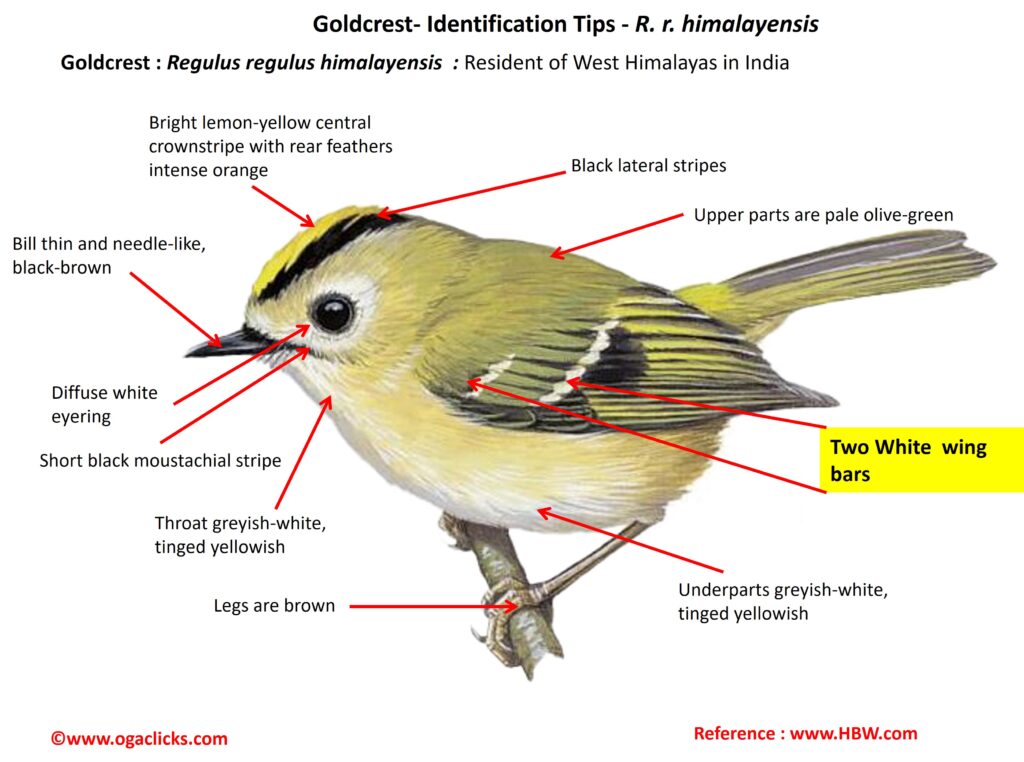
Goldcrest Regulus regulus
Etymology:
- Regulus : Latin word for “ royal, regal” derived from regius- royal
- Regulus : Latin word for “ royal, regal” derived from regius- royal
Sub Species :
- r. himalayensis- Resident of West Himalayas in India {Dark olive-greyish}
- r. sikkimensis- Resident of East Himalayas in India {Darker and greener above}
Distribution :
- r. himalayensis- Resident of West Himalayas in India
- r. sikkimensis- Resident of East Himalayas in India
Description : It has size of 8·5–9·5 cm; wt. of 4·6–7·1 g. It is a tiny olive passerine, fairly compact in appearance, with distinctive face pattern. The male nominate race has bright lemon-yellow central crownstripe with rear feathers intense orange (orange visible only when crest raised), bordered by black lateral stripes, broad but diffuse white eyering (emphasizing dark eye), short black moustachial stripe. The upperparts are pale olive-green, two white wingbars, basal black patch on secondaries forming sharply contrasting rear bar, flight-feathers are narrowly edged yellowish, tertials edged and tipped white. The throat and underparts are greyish-white, tinged yellowish (when plumage fresh). The iris is dark brown; bill is thin and needle-like, black-brown and legs are brown. The female has crown paler and lacking orange feathers. The juvenile is duller than adult, lacks bright crown feathers, has white eyering less conspicuous and with narrow dark brown interior ring. Races vary mainly in plumage coloration and size: race himalayensis is rather dark olive-greyish; sikkimensis is darker and greener above than previous.
Habitat: It is found in Boreal forests dominated by spruce and fir. In non-breeding season, and especially during migration, found in mixed and deciduous forests, shrub vegetation and gardens and parks. It breeds at up to 4000 m in Himalayas .
Food habits: It eats Arthropods such as springtails, aphids, small moths and tiny spiders. It forages mostly by clinging and hanging from twigs. In coniferous habitats, prefers to forage in dense branches, moving up and down vertical twigs; exploits underside of branches more often and more intensely. It also hovers at outer tips of branches, picking prey from substrate or in flight. Sometimes hovers at spider webs, from which picks trapped small insects, sometimes becomes entangled in web and may perish. In Non- breeding season it is found in small, loose groups, frequently with mixed-species flocks.
Breeding habits: They breed in Mar, they lay two broods per breeding season. The nest is built by both sexes. The nest is a regulid cup-nest of three layers, inner layer padded out with large number of small feathers , outer layer consists of strong coat of lichens . The nest is suspended above ground in vertical twigs of conifer; . They lay a clutch of 6–13 eggs, second clutches slightly smaller than first. The incubation is done by female. The incubation period is 14–17 days . The chicks are fed by both sexes. The nestling period is 17–22 days . The fledglings are fed by parents for 12–18 days after having left nest.